Spain Heatwave: Tourism and Hospitality Crisis Management Report
VerifiedAdded on 2022/08/15
|22
|4638
|16
Report
AI Summary
This report provides a comprehensive analysis of crisis management within the tourism and hospitality sectors, specifically addressing the challenges posed by the Spain heatwave. It begins with an introduction outlining the scope and significance of the crisis, emphasizing the impact of the heatwave on tourism and the need for effective management strategies. The report then delves into communication tools and strategies, including proactive damage control, social media response, spokesperson responses, and case escalation, highlighting their roles in mitigating the crisis's effects. Theoretical approaches to crisis management are explored, with a focus on the Faulkner model and the phase model, which is described in detail. The framework of disaster management is presented, including a breakdown of the mitigation, preparedness, response, and recovery phases. Proactive and reactive management strategies are discussed, along with their consequences. The report concludes by emphasizing the importance of effective crisis management in safeguarding the tourism industry and maintaining economic stability, especially in destinations like Spain. The report's content is contributed by a student and available on Desklib, a platform providing AI-based study tools.
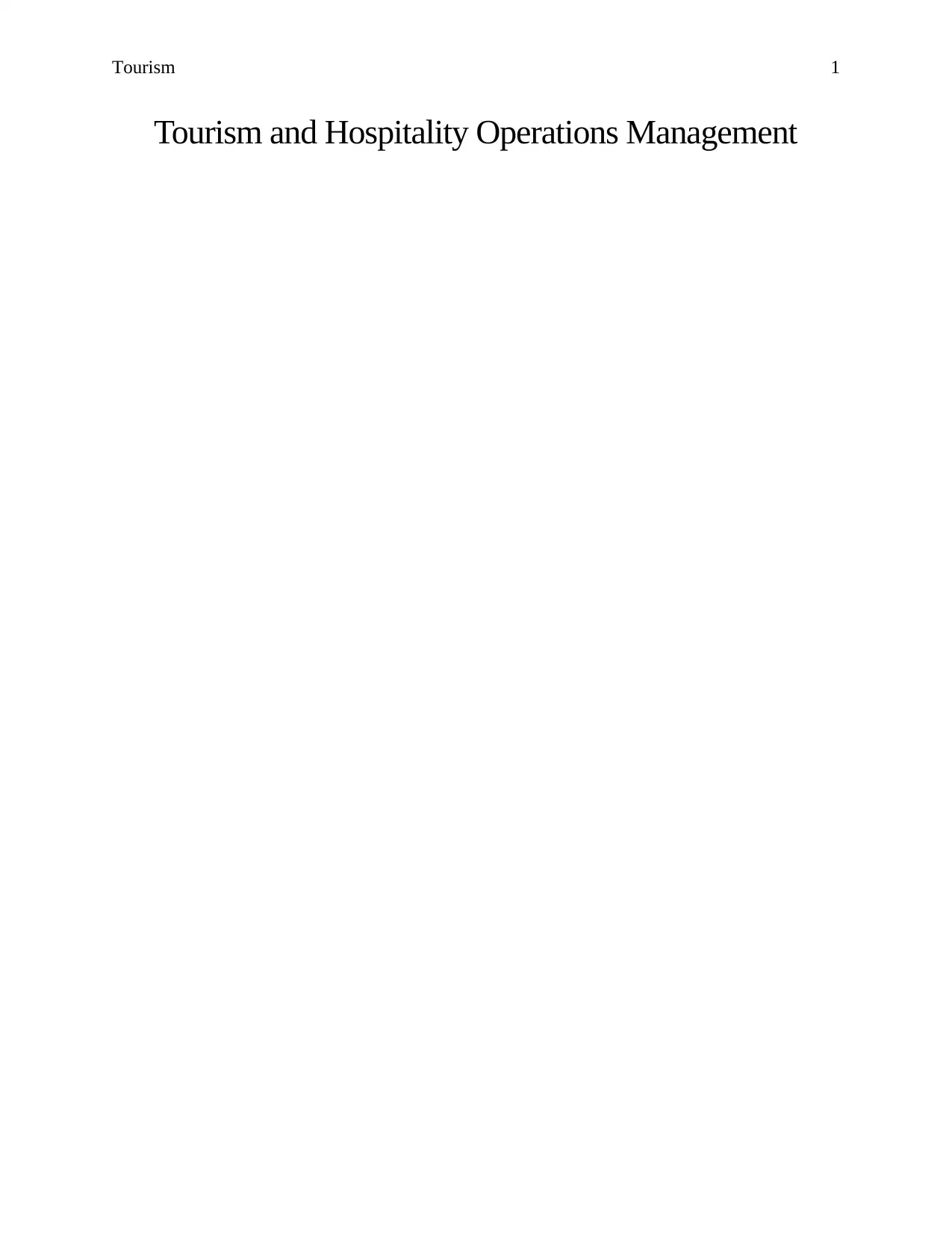
Tourism 1
Tourism and Hospitality Operations Management
Tourism and Hospitality Operations Management
Paraphrase This Document
Need a fresh take? Get an instant paraphrase of this document with our AI Paraphraser
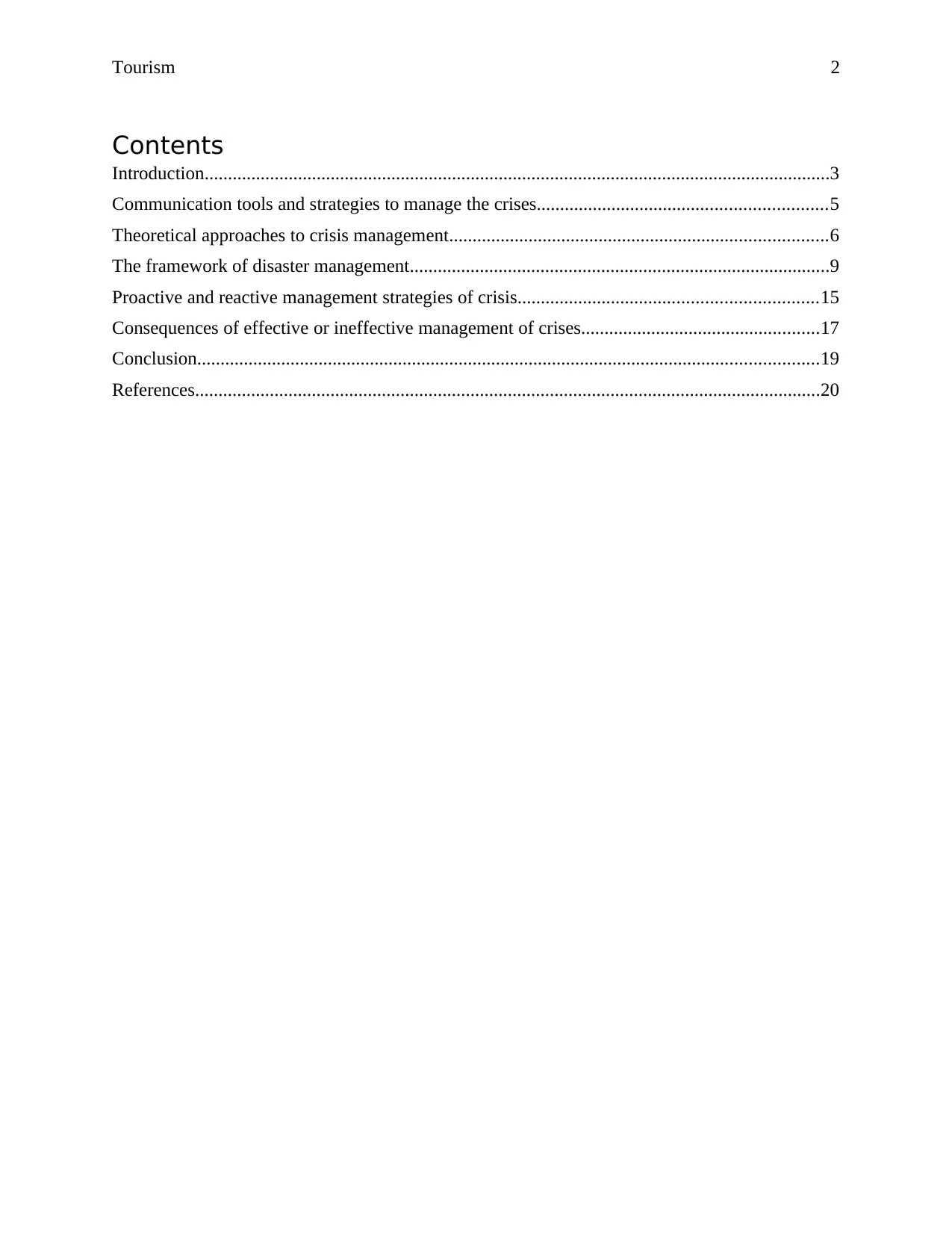
Tourism 2
Contents
Introduction......................................................................................................................................3
Communication tools and strategies to manage the crises..............................................................5
Theoretical approaches to crisis management.................................................................................6
The framework of disaster management..........................................................................................9
Proactive and reactive management strategies of crisis................................................................15
Consequences of effective or ineffective management of crises...................................................17
Conclusion.....................................................................................................................................19
References......................................................................................................................................20
Contents
Introduction......................................................................................................................................3
Communication tools and strategies to manage the crises..............................................................5
Theoretical approaches to crisis management.................................................................................6
The framework of disaster management..........................................................................................9
Proactive and reactive management strategies of crisis................................................................15
Consequences of effective or ineffective management of crises...................................................17
Conclusion.....................................................................................................................................19
References......................................................................................................................................20
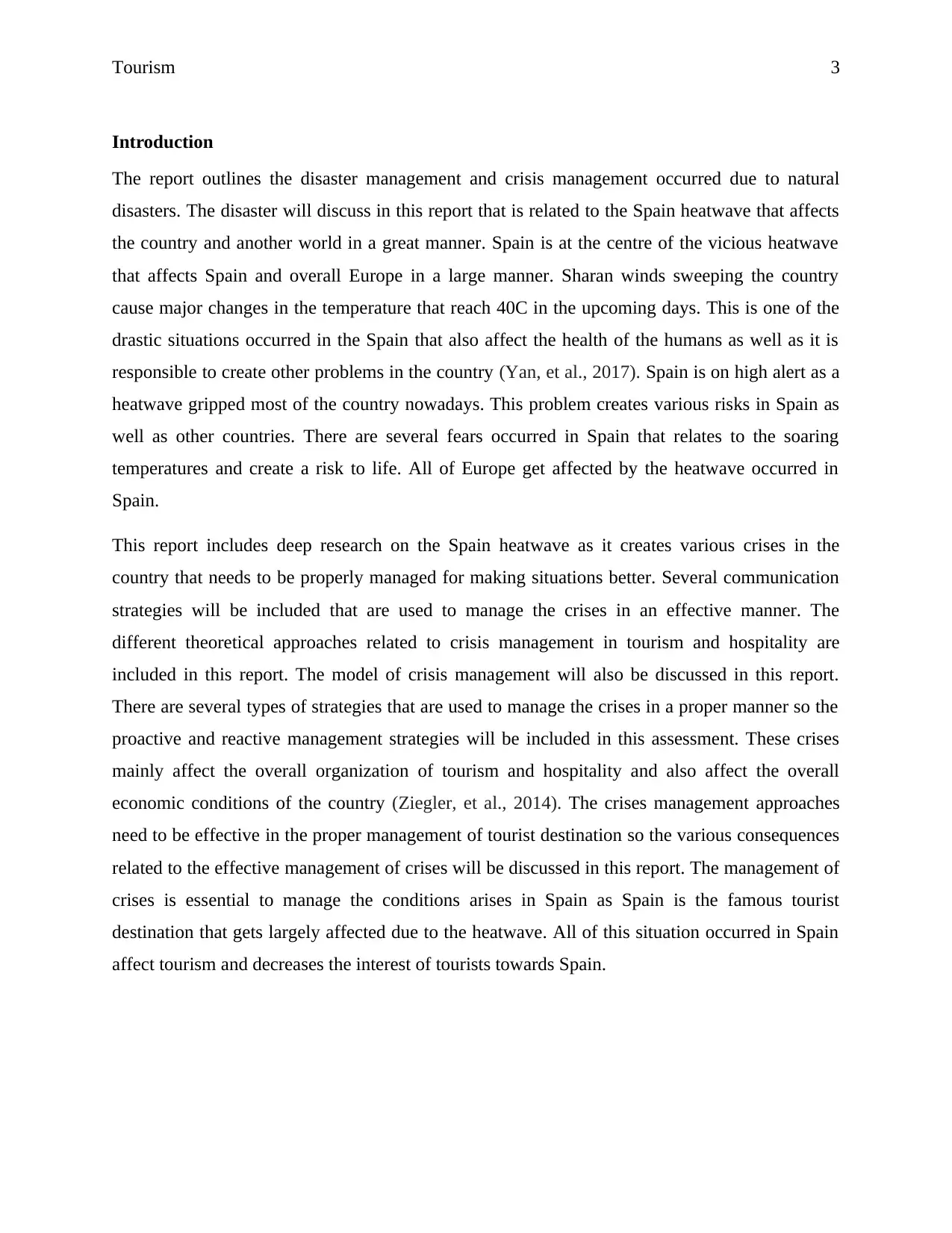
Tourism 3
Introduction
The report outlines the disaster management and crisis management occurred due to natural
disasters. The disaster will discuss in this report that is related to the Spain heatwave that affects
the country and another world in a great manner. Spain is at the centre of the vicious heatwave
that affects Spain and overall Europe in a large manner. Sharan winds sweeping the country
cause major changes in the temperature that reach 40C in the upcoming days. This is one of the
drastic situations occurred in the Spain that also affect the health of the humans as well as it is
responsible to create other problems in the country (Yan, et al., 2017). Spain is on high alert as a
heatwave gripped most of the country nowadays. This problem creates various risks in Spain as
well as other countries. There are several fears occurred in Spain that relates to the soaring
temperatures and create a risk to life. All of Europe get affected by the heatwave occurred in
Spain.
This report includes deep research on the Spain heatwave as it creates various crises in the
country that needs to be properly managed for making situations better. Several communication
strategies will be included that are used to manage the crises in an effective manner. The
different theoretical approaches related to crisis management in tourism and hospitality are
included in this report. The model of crisis management will also be discussed in this report.
There are several types of strategies that are used to manage the crises in a proper manner so the
proactive and reactive management strategies will be included in this assessment. These crises
mainly affect the overall organization of tourism and hospitality and also affect the overall
economic conditions of the country (Ziegler, et al., 2014). The crises management approaches
need to be effective in the proper management of tourist destination so the various consequences
related to the effective management of crises will be discussed in this report. The management of
crises is essential to manage the conditions arises in Spain as Spain is the famous tourist
destination that gets largely affected due to the heatwave. All of this situation occurred in Spain
affect tourism and decreases the interest of tourists towards Spain.
Introduction
The report outlines the disaster management and crisis management occurred due to natural
disasters. The disaster will discuss in this report that is related to the Spain heatwave that affects
the country and another world in a great manner. Spain is at the centre of the vicious heatwave
that affects Spain and overall Europe in a large manner. Sharan winds sweeping the country
cause major changes in the temperature that reach 40C in the upcoming days. This is one of the
drastic situations occurred in the Spain that also affect the health of the humans as well as it is
responsible to create other problems in the country (Yan, et al., 2017). Spain is on high alert as a
heatwave gripped most of the country nowadays. This problem creates various risks in Spain as
well as other countries. There are several fears occurred in Spain that relates to the soaring
temperatures and create a risk to life. All of Europe get affected by the heatwave occurred in
Spain.
This report includes deep research on the Spain heatwave as it creates various crises in the
country that needs to be properly managed for making situations better. Several communication
strategies will be included that are used to manage the crises in an effective manner. The
different theoretical approaches related to crisis management in tourism and hospitality are
included in this report. The model of crisis management will also be discussed in this report.
There are several types of strategies that are used to manage the crises in a proper manner so the
proactive and reactive management strategies will be included in this assessment. These crises
mainly affect the overall organization of tourism and hospitality and also affect the overall
economic conditions of the country (Ziegler, et al., 2014). The crises management approaches
need to be effective in the proper management of tourist destination so the various consequences
related to the effective management of crises will be discussed in this report. The management of
crises is essential to manage the conditions arises in Spain as Spain is the famous tourist
destination that gets largely affected due to the heatwave. All of this situation occurred in Spain
affect tourism and decreases the interest of tourists towards Spain.
⊘ This is a preview!⊘
Do you want full access?
Subscribe today to unlock all pages.

Trusted by 1+ million students worldwide
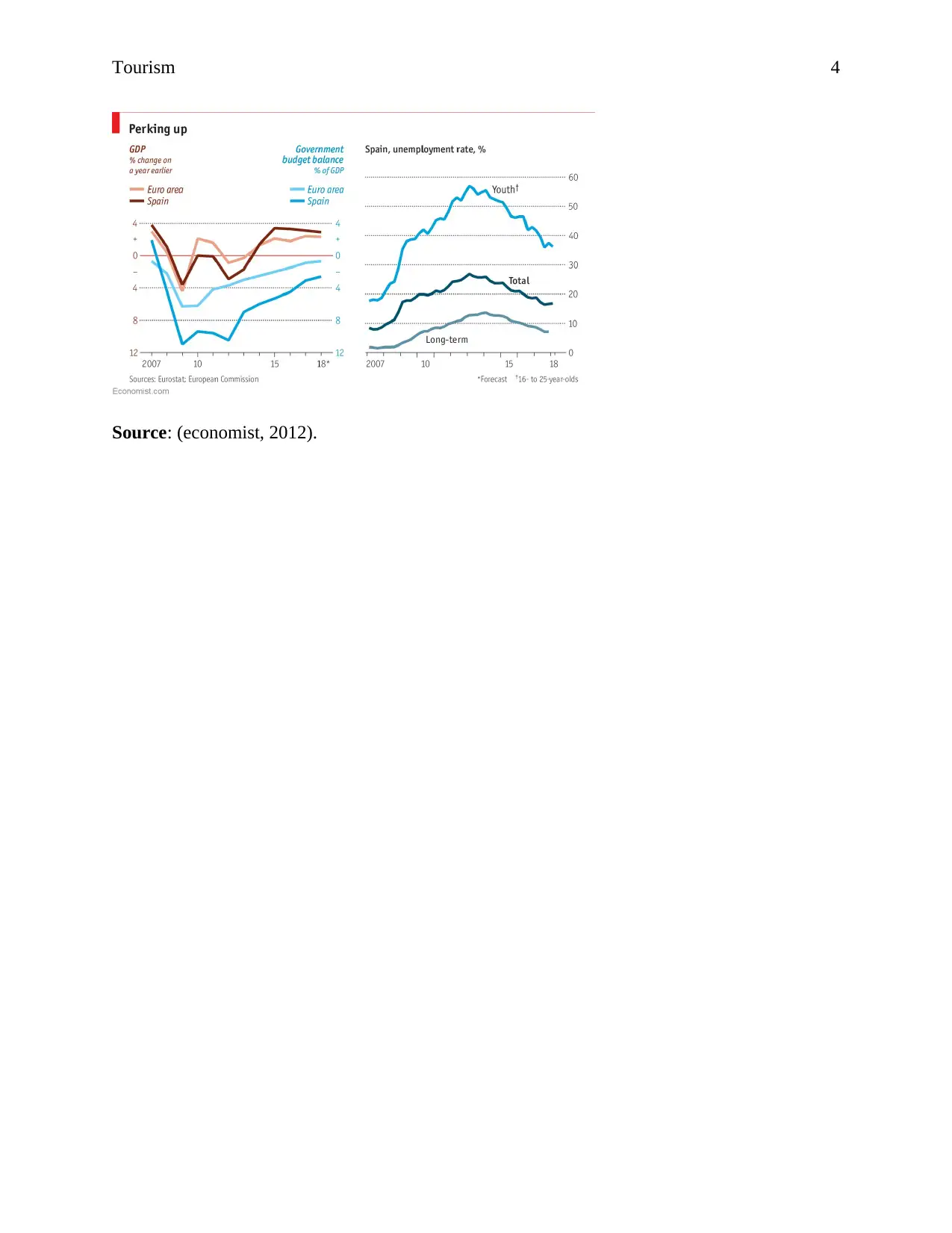
Tourism 4
Source: (economist, 2012).
Source: (economist, 2012).
Paraphrase This Document
Need a fresh take? Get an instant paraphrase of this document with our AI Paraphraser
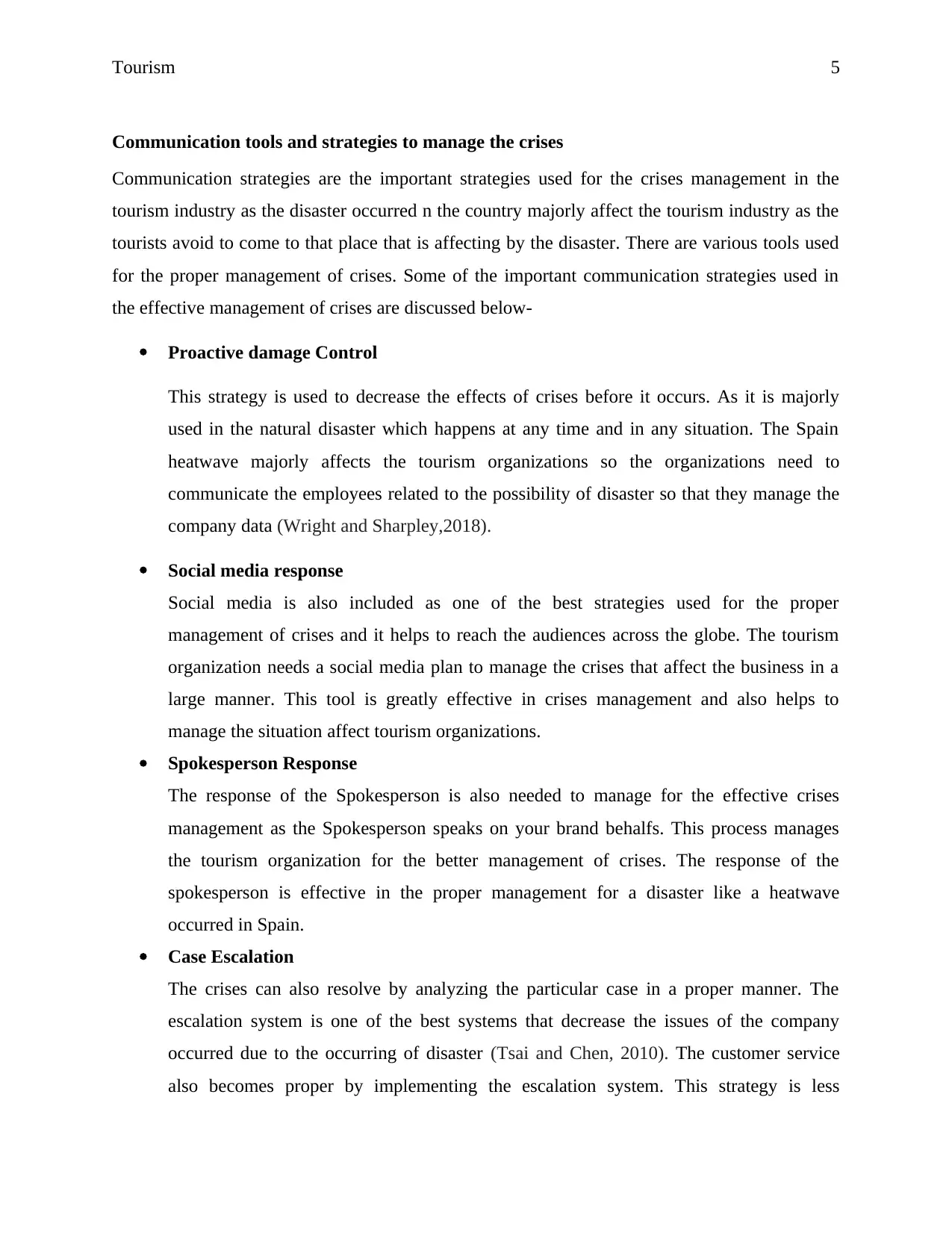
Tourism 5
Communication tools and strategies to manage the crises
Communication strategies are the important strategies used for the crises management in the
tourism industry as the disaster occurred n the country majorly affect the tourism industry as the
tourists avoid to come to that place that is affecting by the disaster. There are various tools used
for the proper management of crises. Some of the important communication strategies used in
the effective management of crises are discussed below-
Proactive damage Control
This strategy is used to decrease the effects of crises before it occurs. As it is majorly
used in the natural disaster which happens at any time and in any situation. The Spain
heatwave majorly affects the tourism organizations so the organizations need to
communicate the employees related to the possibility of disaster so that they manage the
company data (Wright and Sharpley,2018).
Social media response
Social media is also included as one of the best strategies used for the proper
management of crises and it helps to reach the audiences across the globe. The tourism
organization needs a social media plan to manage the crises that affect the business in a
large manner. This tool is greatly effective in crises management and also helps to
manage the situation affect tourism organizations.
Spokesperson Response
The response of the Spokesperson is also needed to manage for the effective crises
management as the Spokesperson speaks on your brand behalfs. This process manages
the tourism organization for the better management of crises. The response of the
spokesperson is effective in the proper management for a disaster like a heatwave
occurred in Spain.
Case Escalation
The crises can also resolve by analyzing the particular case in a proper manner. The
escalation system is one of the best systems that decrease the issues of the company
occurred due to the occurring of disaster (Tsai and Chen, 2010). The customer service
also becomes proper by implementing the escalation system. This strategy is less
Communication tools and strategies to manage the crises
Communication strategies are the important strategies used for the crises management in the
tourism industry as the disaster occurred n the country majorly affect the tourism industry as the
tourists avoid to come to that place that is affecting by the disaster. There are various tools used
for the proper management of crises. Some of the important communication strategies used in
the effective management of crises are discussed below-
Proactive damage Control
This strategy is used to decrease the effects of crises before it occurs. As it is majorly
used in the natural disaster which happens at any time and in any situation. The Spain
heatwave majorly affects the tourism organizations so the organizations need to
communicate the employees related to the possibility of disaster so that they manage the
company data (Wright and Sharpley,2018).
Social media response
Social media is also included as one of the best strategies used for the proper
management of crises and it helps to reach the audiences across the globe. The tourism
organization needs a social media plan to manage the crises that affect the business in a
large manner. This tool is greatly effective in crises management and also helps to
manage the situation affect tourism organizations.
Spokesperson Response
The response of the Spokesperson is also needed to manage for the effective crises
management as the Spokesperson speaks on your brand behalfs. This process manages
the tourism organization for the better management of crises. The response of the
spokesperson is effective in the proper management for a disaster like a heatwave
occurred in Spain.
Case Escalation
The crises can also resolve by analyzing the particular case in a proper manner. The
escalation system is one of the best systems that decrease the issues of the company
occurred due to the occurring of disaster (Tsai and Chen, 2010). The customer service
also becomes proper by implementing the escalation system. This strategy is less
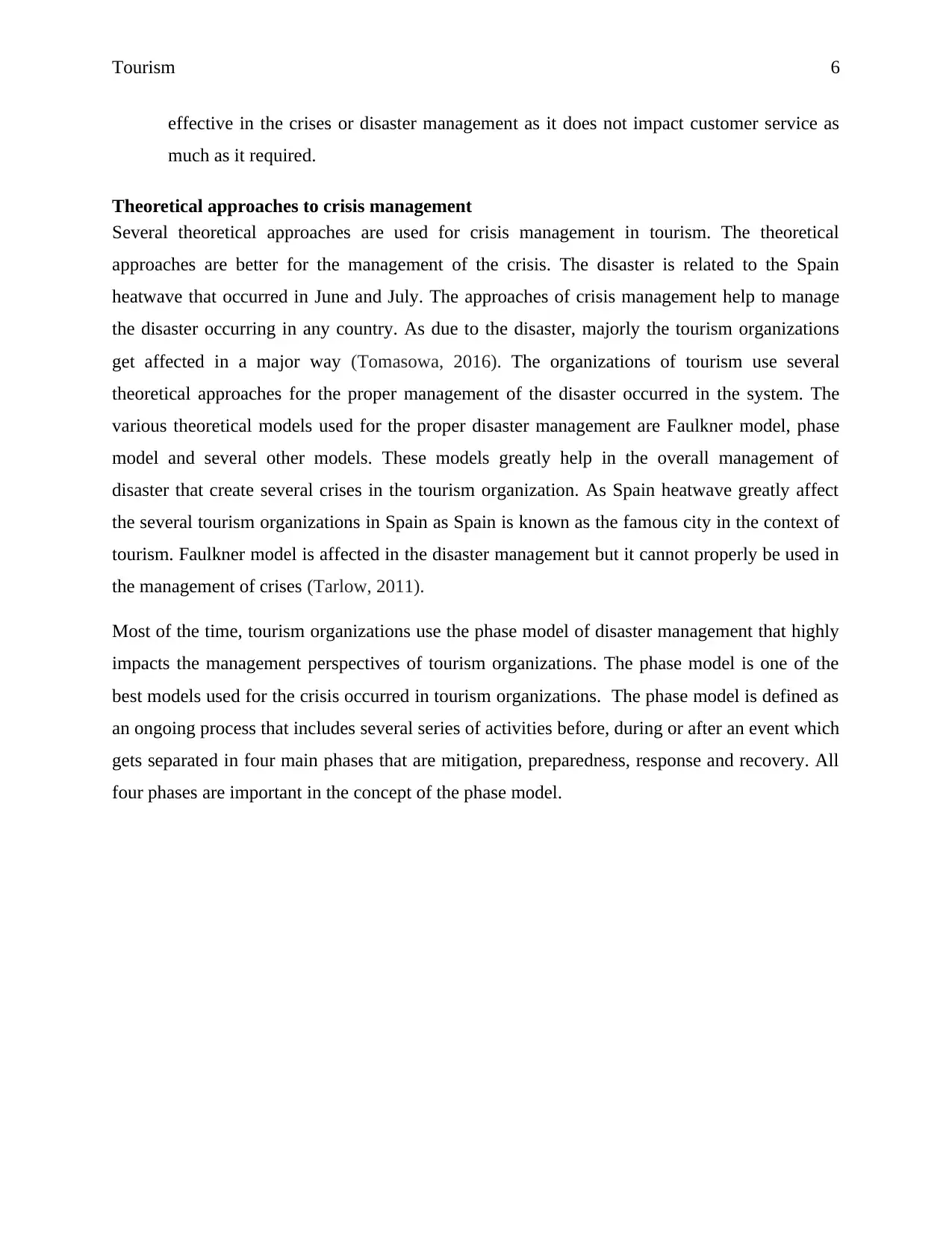
Tourism 6
effective in the crises or disaster management as it does not impact customer service as
much as it required.
Theoretical approaches to crisis management
Several theoretical approaches are used for crisis management in tourism. The theoretical
approaches are better for the management of the crisis. The disaster is related to the Spain
heatwave that occurred in June and July. The approaches of crisis management help to manage
the disaster occurring in any country. As due to the disaster, majorly the tourism organizations
get affected in a major way (Tomasowa, 2016). The organizations of tourism use several
theoretical approaches for the proper management of the disaster occurred in the system. The
various theoretical models used for the proper disaster management are Faulkner model, phase
model and several other models. These models greatly help in the overall management of
disaster that create several crises in the tourism organization. As Spain heatwave greatly affect
the several tourism organizations in Spain as Spain is known as the famous city in the context of
tourism. Faulkner model is affected in the disaster management but it cannot properly be used in
the management of crises (Tarlow, 2011).
Most of the time, tourism organizations use the phase model of disaster management that highly
impacts the management perspectives of tourism organizations. The phase model is one of the
best models used for the crisis occurred in tourism organizations. The phase model is defined as
an ongoing process that includes several series of activities before, during or after an event which
gets separated in four main phases that are mitigation, preparedness, response and recovery. All
four phases are important in the concept of the phase model.
effective in the crises or disaster management as it does not impact customer service as
much as it required.
Theoretical approaches to crisis management
Several theoretical approaches are used for crisis management in tourism. The theoretical
approaches are better for the management of the crisis. The disaster is related to the Spain
heatwave that occurred in June and July. The approaches of crisis management help to manage
the disaster occurring in any country. As due to the disaster, majorly the tourism organizations
get affected in a major way (Tomasowa, 2016). The organizations of tourism use several
theoretical approaches for the proper management of the disaster occurred in the system. The
various theoretical models used for the proper disaster management are Faulkner model, phase
model and several other models. These models greatly help in the overall management of
disaster that create several crises in the tourism organization. As Spain heatwave greatly affect
the several tourism organizations in Spain as Spain is known as the famous city in the context of
tourism. Faulkner model is affected in the disaster management but it cannot properly be used in
the management of crises (Tarlow, 2011).
Most of the time, tourism organizations use the phase model of disaster management that highly
impacts the management perspectives of tourism organizations. The phase model is one of the
best models used for the crisis occurred in tourism organizations. The phase model is defined as
an ongoing process that includes several series of activities before, during or after an event which
gets separated in four main phases that are mitigation, preparedness, response and recovery. All
four phases are important in the concept of the phase model.
⊘ This is a preview!⊘
Do you want full access?
Subscribe today to unlock all pages.

Trusted by 1+ million students worldwide
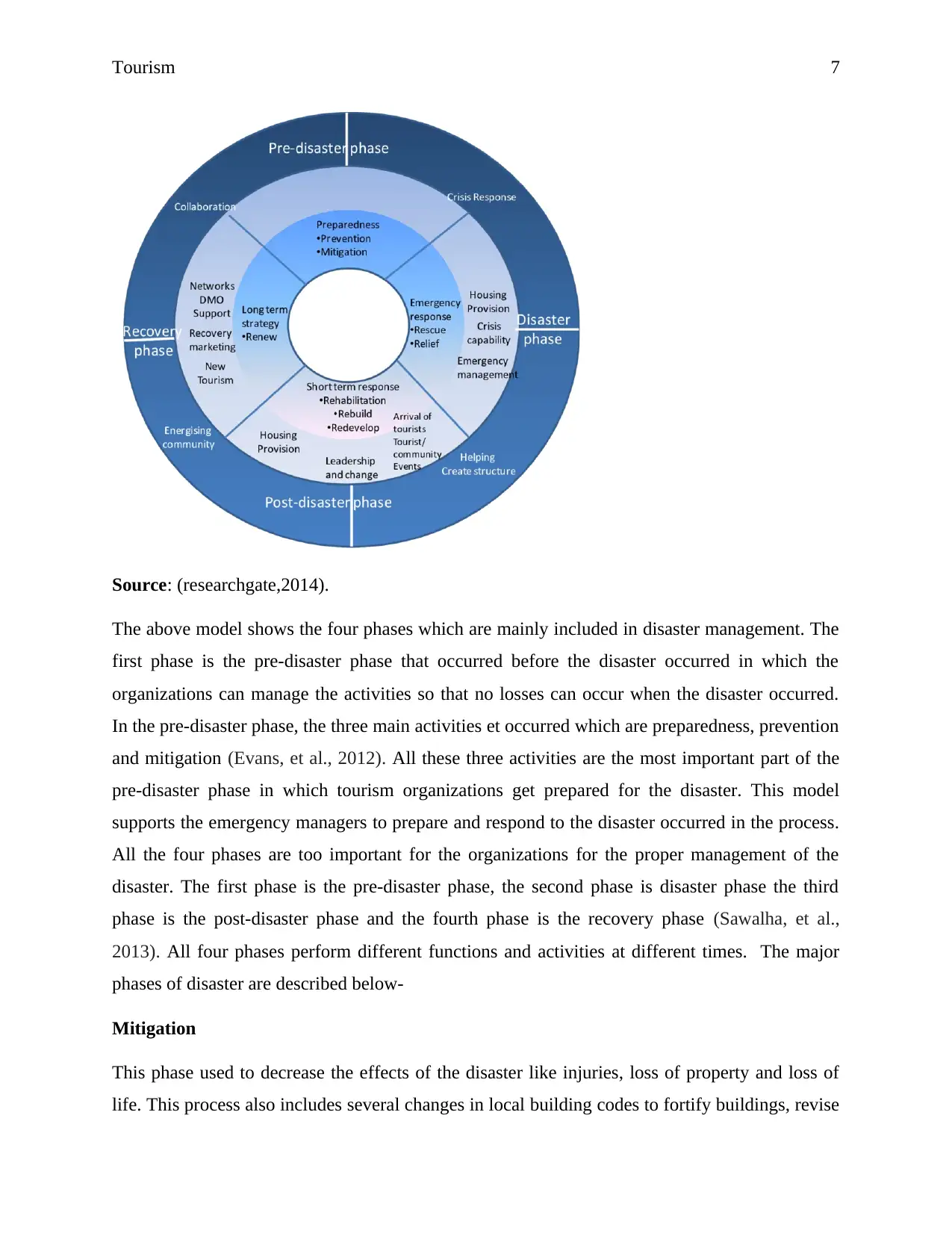
Tourism 7
Source: (researchgate,2014).
The above model shows the four phases which are mainly included in disaster management. The
first phase is the pre-disaster phase that occurred before the disaster occurred in which the
organizations can manage the activities so that no losses can occur when the disaster occurred.
In the pre-disaster phase, the three main activities et occurred which are preparedness, prevention
and mitigation (Evans, et al., 2012). All these three activities are the most important part of the
pre-disaster phase in which tourism organizations get prepared for the disaster. This model
supports the emergency managers to prepare and respond to the disaster occurred in the process.
All the four phases are too important for the organizations for the proper management of the
disaster. The first phase is the pre-disaster phase, the second phase is disaster phase the third
phase is the post-disaster phase and the fourth phase is the recovery phase (Sawalha, et al.,
2013). All four phases perform different functions and activities at different times. The major
phases of disaster are described below-
Mitigation
This phase used to decrease the effects of the disaster like injuries, loss of property and loss of
life. This process also includes several changes in local building codes to fortify buildings, revise
Source: (researchgate,2014).
The above model shows the four phases which are mainly included in disaster management. The
first phase is the pre-disaster phase that occurred before the disaster occurred in which the
organizations can manage the activities so that no losses can occur when the disaster occurred.
In the pre-disaster phase, the three main activities et occurred which are preparedness, prevention
and mitigation (Evans, et al., 2012). All these three activities are the most important part of the
pre-disaster phase in which tourism organizations get prepared for the disaster. This model
supports the emergency managers to prepare and respond to the disaster occurred in the process.
All the four phases are too important for the organizations for the proper management of the
disaster. The first phase is the pre-disaster phase, the second phase is disaster phase the third
phase is the post-disaster phase and the fourth phase is the recovery phase (Sawalha, et al.,
2013). All four phases perform different functions and activities at different times. The major
phases of disaster are described below-
Mitigation
This phase used to decrease the effects of the disaster like injuries, loss of property and loss of
life. This process also includes several changes in local building codes to fortify buildings, revise
Paraphrase This Document
Need a fresh take? Get an instant paraphrase of this document with our AI Paraphraser
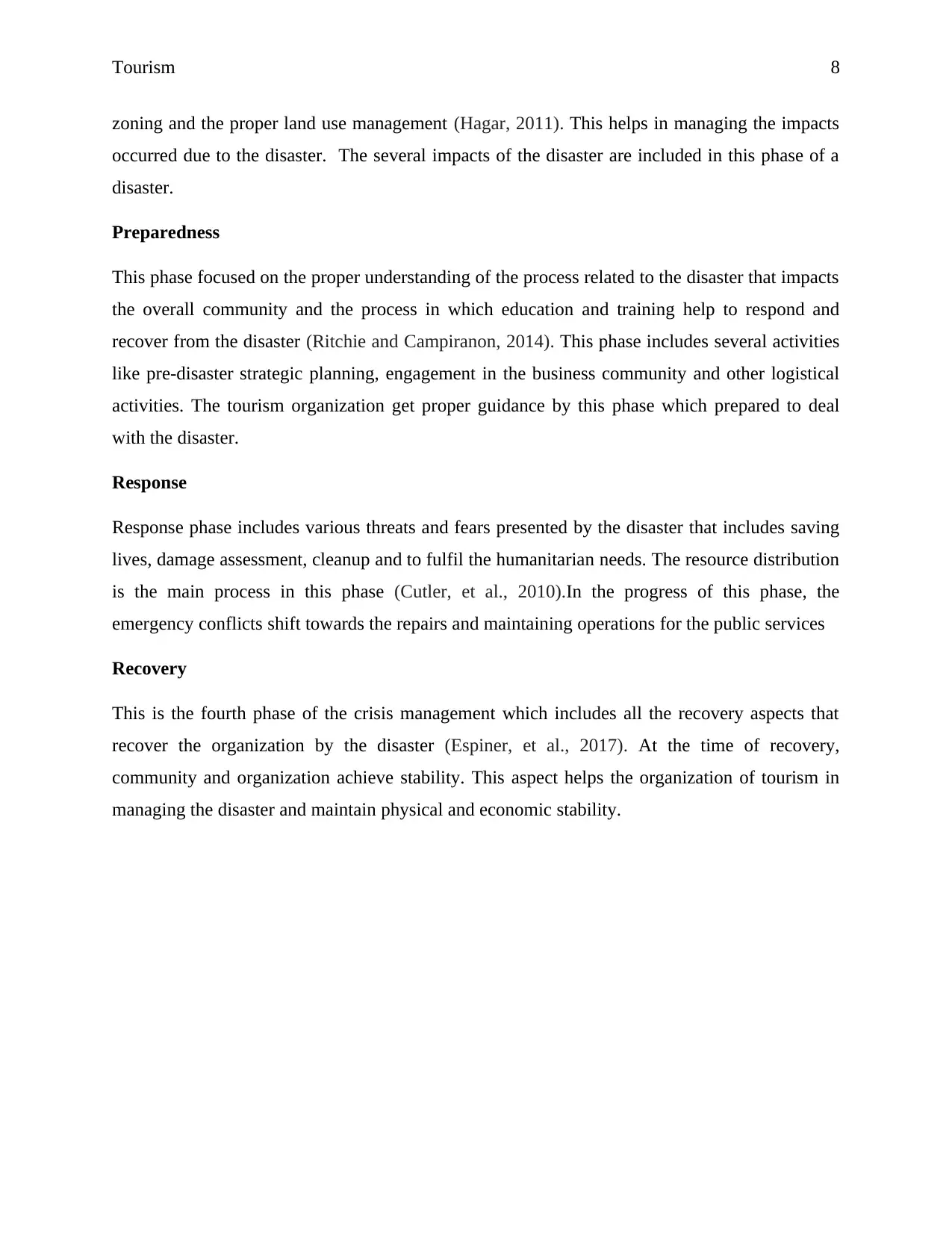
Tourism 8
zoning and the proper land use management (Hagar, 2011). This helps in managing the impacts
occurred due to the disaster. The several impacts of the disaster are included in this phase of a
disaster.
Preparedness
This phase focused on the proper understanding of the process related to the disaster that impacts
the overall community and the process in which education and training help to respond and
recover from the disaster (Ritchie and Campiranon, 2014). This phase includes several activities
like pre-disaster strategic planning, engagement in the business community and other logistical
activities. The tourism organization get proper guidance by this phase which prepared to deal
with the disaster.
Response
Response phase includes various threats and fears presented by the disaster that includes saving
lives, damage assessment, cleanup and to fulfil the humanitarian needs. The resource distribution
is the main process in this phase (Cutler, et al., 2010).In the progress of this phase, the
emergency conflicts shift towards the repairs and maintaining operations for the public services
Recovery
This is the fourth phase of the crisis management which includes all the recovery aspects that
recover the organization by the disaster (Espiner, et al., 2017). At the time of recovery,
community and organization achieve stability. This aspect helps the organization of tourism in
managing the disaster and maintain physical and economic stability.
zoning and the proper land use management (Hagar, 2011). This helps in managing the impacts
occurred due to the disaster. The several impacts of the disaster are included in this phase of a
disaster.
Preparedness
This phase focused on the proper understanding of the process related to the disaster that impacts
the overall community and the process in which education and training help to respond and
recover from the disaster (Ritchie and Campiranon, 2014). This phase includes several activities
like pre-disaster strategic planning, engagement in the business community and other logistical
activities. The tourism organization get proper guidance by this phase which prepared to deal
with the disaster.
Response
Response phase includes various threats and fears presented by the disaster that includes saving
lives, damage assessment, cleanup and to fulfil the humanitarian needs. The resource distribution
is the main process in this phase (Cutler, et al., 2010).In the progress of this phase, the
emergency conflicts shift towards the repairs and maintaining operations for the public services
Recovery
This is the fourth phase of the crisis management which includes all the recovery aspects that
recover the organization by the disaster (Espiner, et al., 2017). At the time of recovery,
community and organization achieve stability. This aspect helps the organization of tourism in
managing the disaster and maintain physical and economic stability.
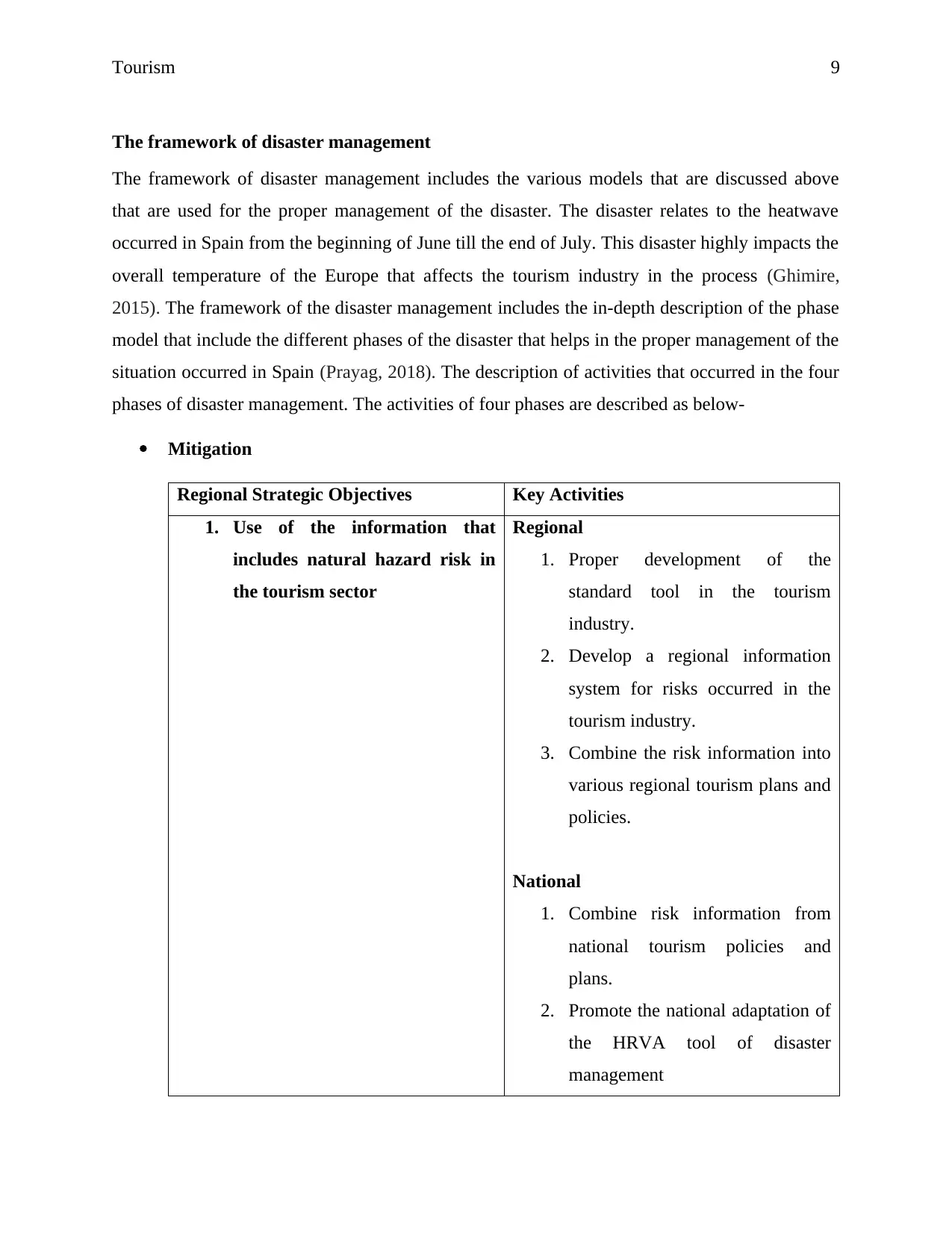
Tourism 9
The framework of disaster management
The framework of disaster management includes the various models that are discussed above
that are used for the proper management of the disaster. The disaster relates to the heatwave
occurred in Spain from the beginning of June till the end of July. This disaster highly impacts the
overall temperature of the Europe that affects the tourism industry in the process (Ghimire,
2015). The framework of the disaster management includes the in-depth description of the phase
model that include the different phases of the disaster that helps in the proper management of the
situation occurred in Spain (Prayag, 2018). The description of activities that occurred in the four
phases of disaster management. The activities of four phases are described as below-
Mitigation
Regional Strategic Objectives Key Activities
1. Use of the information that
includes natural hazard risk in
the tourism sector
Regional
1. Proper development of the
standard tool in the tourism
industry.
2. Develop a regional information
system for risks occurred in the
tourism industry.
3. Combine the risk information into
various regional tourism plans and
policies.
National
1. Combine risk information from
national tourism policies and
plans.
2. Promote the national adaptation of
the HRVA tool of disaster
management
The framework of disaster management
The framework of disaster management includes the various models that are discussed above
that are used for the proper management of the disaster. The disaster relates to the heatwave
occurred in Spain from the beginning of June till the end of July. This disaster highly impacts the
overall temperature of the Europe that affects the tourism industry in the process (Ghimire,
2015). The framework of the disaster management includes the in-depth description of the phase
model that include the different phases of the disaster that helps in the proper management of the
situation occurred in Spain (Prayag, 2018). The description of activities that occurred in the four
phases of disaster management. The activities of four phases are described as below-
Mitigation
Regional Strategic Objectives Key Activities
1. Use of the information that
includes natural hazard risk in
the tourism sector
Regional
1. Proper development of the
standard tool in the tourism
industry.
2. Develop a regional information
system for risks occurred in the
tourism industry.
3. Combine the risk information into
various regional tourism plans and
policies.
National
1. Combine risk information from
national tourism policies and
plans.
2. Promote the national adaptation of
the HRVA tool of disaster
management
⊘ This is a preview!⊘
Do you want full access?
Subscribe today to unlock all pages.

Trusted by 1+ million students worldwide
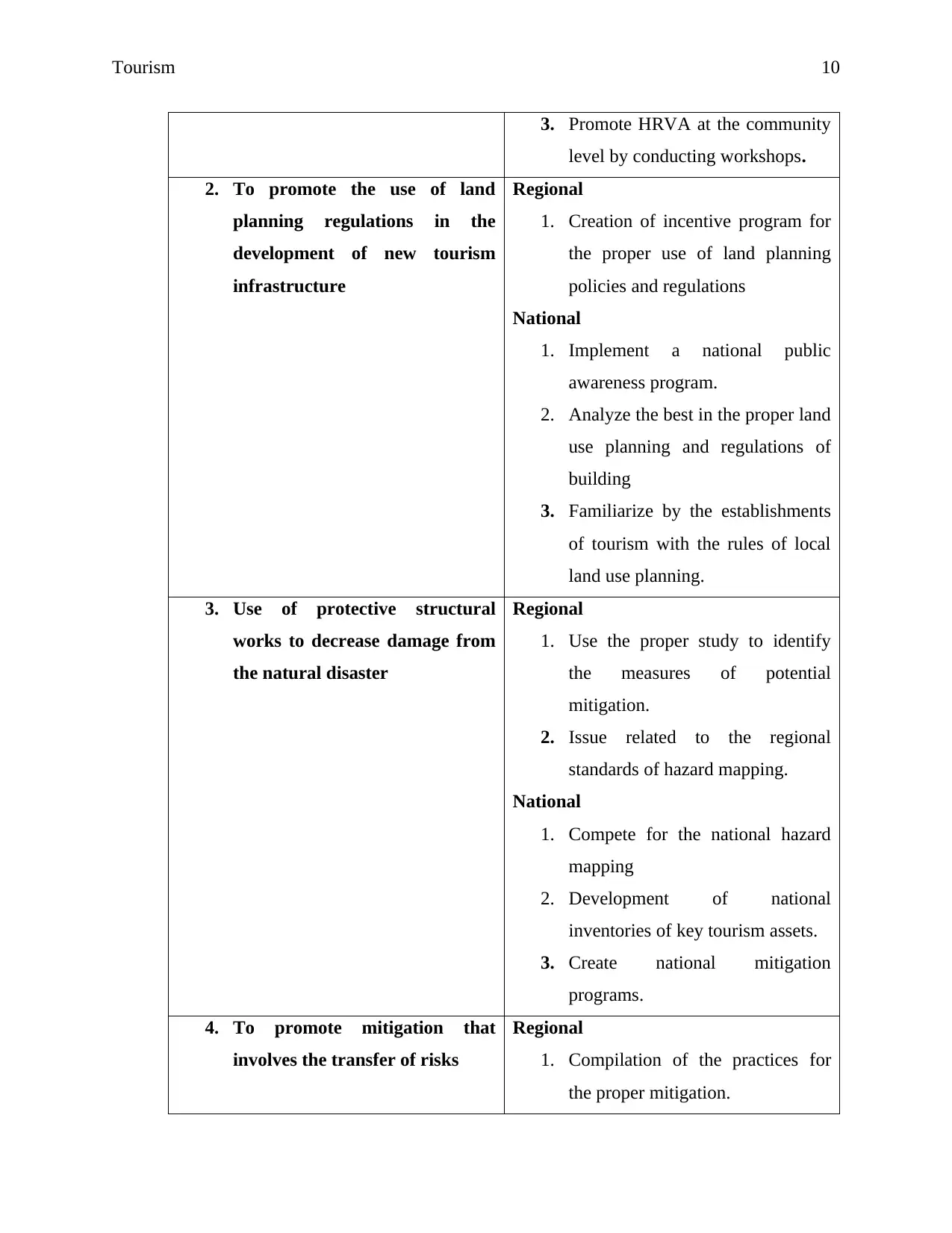
Tourism 10
3. Promote HRVA at the community
level by conducting workshops.
2. To promote the use of land
planning regulations in the
development of new tourism
infrastructure
Regional
1. Creation of incentive program for
the proper use of land planning
policies and regulations
National
1. Implement a national public
awareness program.
2. Analyze the best in the proper land
use planning and regulations of
building
3. Familiarize by the establishments
of tourism with the rules of local
land use planning.
3. Use of protective structural
works to decrease damage from
the natural disaster
Regional
1. Use the proper study to identify
the measures of potential
mitigation.
2. Issue related to the regional
standards of hazard mapping.
National
1. Compete for the national hazard
mapping
2. Development of national
inventories of key tourism assets.
3. Create national mitigation
programs.
4. To promote mitigation that
involves the transfer of risks
Regional
1. Compilation of the practices for
the proper mitigation.
3. Promote HRVA at the community
level by conducting workshops.
2. To promote the use of land
planning regulations in the
development of new tourism
infrastructure
Regional
1. Creation of incentive program for
the proper use of land planning
policies and regulations
National
1. Implement a national public
awareness program.
2. Analyze the best in the proper land
use planning and regulations of
building
3. Familiarize by the establishments
of tourism with the rules of local
land use planning.
3. Use of protective structural
works to decrease damage from
the natural disaster
Regional
1. Use the proper study to identify
the measures of potential
mitigation.
2. Issue related to the regional
standards of hazard mapping.
National
1. Compete for the national hazard
mapping
2. Development of national
inventories of key tourism assets.
3. Create national mitigation
programs.
4. To promote mitigation that
involves the transfer of risks
Regional
1. Compilation of the practices for
the proper mitigation.
Paraphrase This Document
Need a fresh take? Get an instant paraphrase of this document with our AI Paraphraser
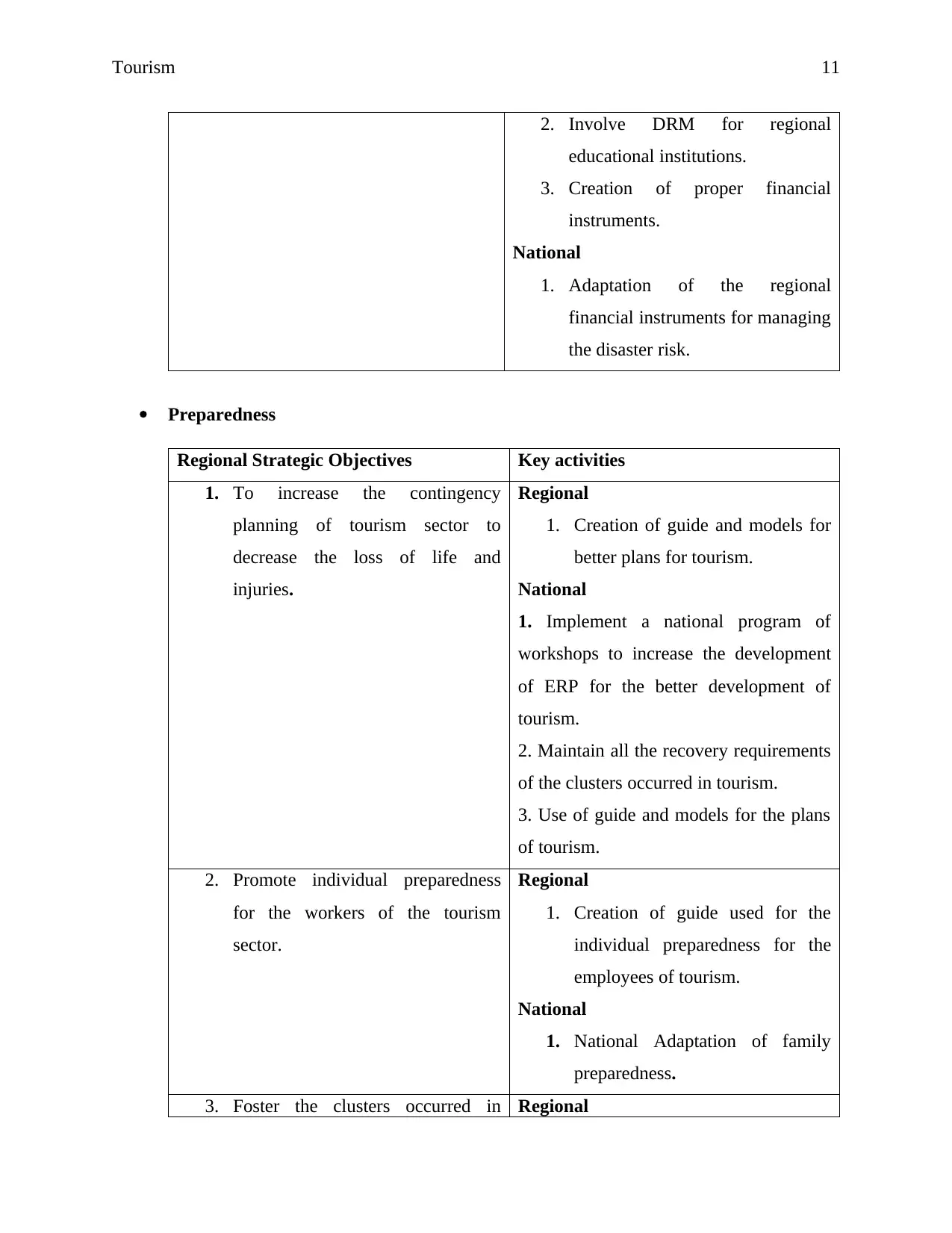
Tourism 11
2. Involve DRM for regional
educational institutions.
3. Creation of proper financial
instruments.
National
1. Adaptation of the regional
financial instruments for managing
the disaster risk.
Preparedness
Regional Strategic Objectives Key activities
1. To increase the contingency
planning of tourism sector to
decrease the loss of life and
injuries.
Regional
1. Creation of guide and models for
better plans for tourism.
National
1. Implement a national program of
workshops to increase the development
of ERP for the better development of
tourism.
2. Maintain all the recovery requirements
of the clusters occurred in tourism.
3. Use of guide and models for the plans
of tourism.
2. Promote individual preparedness
for the workers of the tourism
sector.
Regional
1. Creation of guide used for the
individual preparedness for the
employees of tourism.
National
1. National Adaptation of family
preparedness.
3. Foster the clusters occurred in Regional
2. Involve DRM for regional
educational institutions.
3. Creation of proper financial
instruments.
National
1. Adaptation of the regional
financial instruments for managing
the disaster risk.
Preparedness
Regional Strategic Objectives Key activities
1. To increase the contingency
planning of tourism sector to
decrease the loss of life and
injuries.
Regional
1. Creation of guide and models for
better plans for tourism.
National
1. Implement a national program of
workshops to increase the development
of ERP for the better development of
tourism.
2. Maintain all the recovery requirements
of the clusters occurred in tourism.
3. Use of guide and models for the plans
of tourism.
2. Promote individual preparedness
for the workers of the tourism
sector.
Regional
1. Creation of guide used for the
individual preparedness for the
employees of tourism.
National
1. National Adaptation of family
preparedness.
3. Foster the clusters occurred in Regional
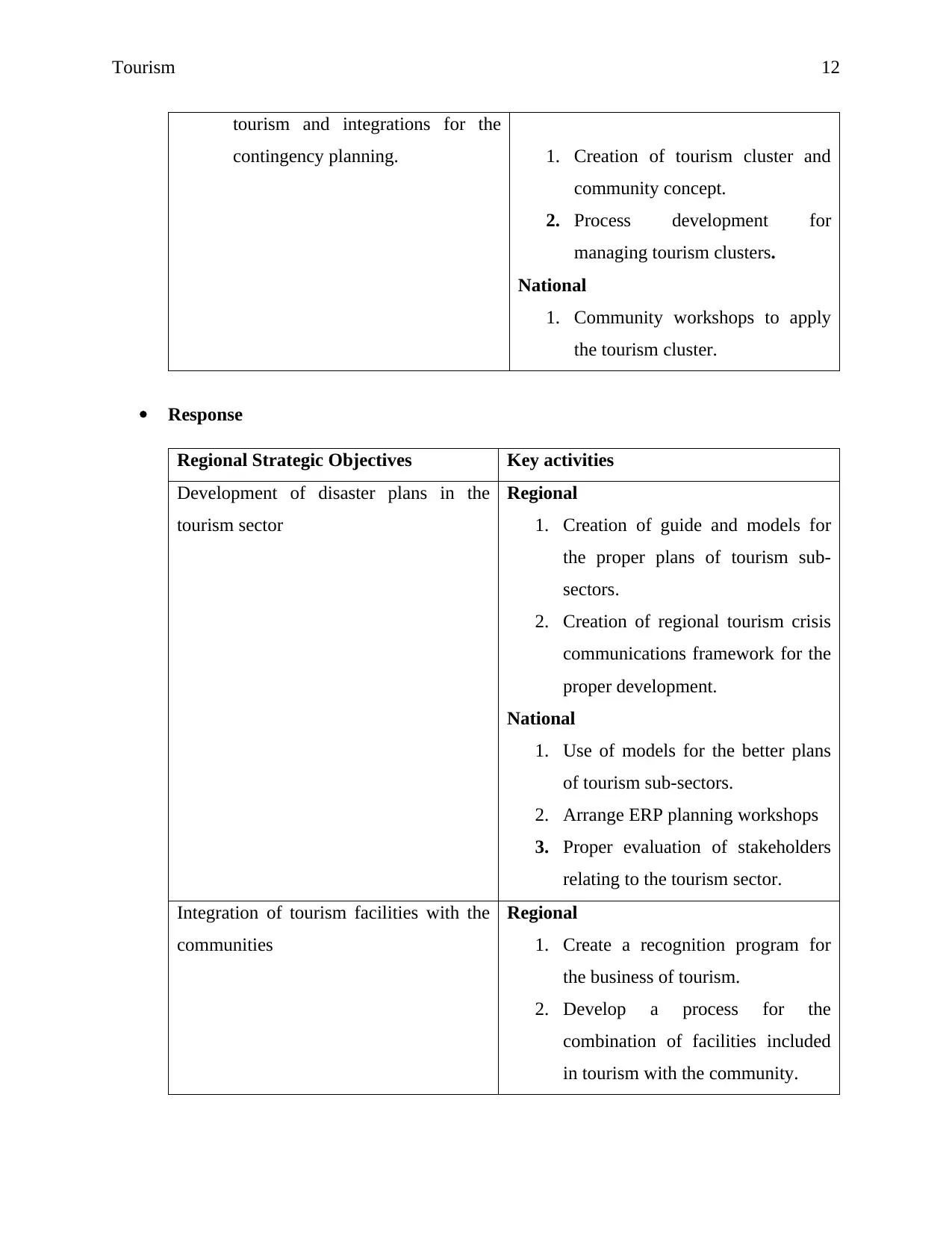
Tourism 12
tourism and integrations for the
contingency planning. 1. Creation of tourism cluster and
community concept.
2. Process development for
managing tourism clusters.
National
1. Community workshops to apply
the tourism cluster.
Response
Regional Strategic Objectives Key activities
Development of disaster plans in the
tourism sector
Regional
1. Creation of guide and models for
the proper plans of tourism sub-
sectors.
2. Creation of regional tourism crisis
communications framework for the
proper development.
National
1. Use of models for the better plans
of tourism sub-sectors.
2. Arrange ERP planning workshops
3. Proper evaluation of stakeholders
relating to the tourism sector.
Integration of tourism facilities with the
communities
Regional
1. Create a recognition program for
the business of tourism.
2. Develop a process for the
combination of facilities included
in tourism with the community.
tourism and integrations for the
contingency planning. 1. Creation of tourism cluster and
community concept.
2. Process development for
managing tourism clusters.
National
1. Community workshops to apply
the tourism cluster.
Response
Regional Strategic Objectives Key activities
Development of disaster plans in the
tourism sector
Regional
1. Creation of guide and models for
the proper plans of tourism sub-
sectors.
2. Creation of regional tourism crisis
communications framework for the
proper development.
National
1. Use of models for the better plans
of tourism sub-sectors.
2. Arrange ERP planning workshops
3. Proper evaluation of stakeholders
relating to the tourism sector.
Integration of tourism facilities with the
communities
Regional
1. Create a recognition program for
the business of tourism.
2. Develop a process for the
combination of facilities included
in tourism with the community.
⊘ This is a preview!⊘
Do you want full access?
Subscribe today to unlock all pages.

Trusted by 1+ million students worldwide
1 out of 22
Related Documents
Your All-in-One AI-Powered Toolkit for Academic Success.
+13062052269
info@desklib.com
Available 24*7 on WhatsApp / Email
![[object Object]](/_next/static/media/star-bottom.7253800d.svg)
Unlock your academic potential
Copyright © 2020–2025 A2Z Services. All Rights Reserved. Developed and managed by ZUCOL.





